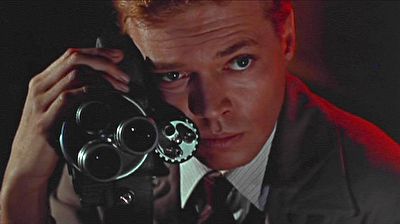stills from
Peeping Tom
|



|



|



|
|
[click photos for larger versions]
|
Armed with a 16mm camera, which rarely leaves his side, Mark lives to
photograph the final death throes of his victims. Turning a mirror toward
their faces, he forces his victims to see their own fear before plunging
a spike/tripod leg into their throats. He wants to capture the perfect
image of fear on film. The murders he commits are simply a means to an end,
for Mark Lewis derives pleasure not from the act of murder itself but from
watching the projected results. For Mark, this is a never-ending quest,
for he always finds something wrong with the images (i.e., he can never
satisfy his father's quest for perfection).
When Mark plays back the murders he has photographed, we become complicit.
We become implicated as voyeurs, with the act of watching associated with
sadism and the need to control.
Mark still lives in the house where he grew up. To supplement his income,
he leases the rooms on the first floor. One of the renters, Helen
(Anna Massey), becomes attracted to Mark. She sees a shy and sensitive
young man and wants to break through the barrier that he has erected
around himself. And she finds some limited success. At one point, she
even gets Mark to leave his camera behind when they go out on a date.
But as he begins to care about Helen, Mark begins to fear what might
happen if he focuses his camera upon her: "It will never see you. Whatever
I photograph, I lose," he says.
Contrasted with Helen is the reaction of her mother, who also lives
downstairs. Unlike Helen, Mrs. Stephens (Maxine Audley) is suspicious
of Mark. She is blind, but she intuitively knows that Mark is troubled.
In one of the movie's key sequences, she visits his apartment while he's out.
When Mark comes home, he discovers her in the shadows. She photographs
Mark by running her hands over his face. Her method of remembering
implies the intimacy of human contact--which is posited in contrast to
Mark's emotional isolation. Sight can be a disadvantage, for Mark has
become a slave to his fetish object--his camera--and the images that it
can supply. Helen even calls it his "extra limb."
This new Criterion Collection release of Peeping Tom is loaded
with extras. Film theorist Laura Mulvey provides commentary on an
alternate audio track. Most of her comments are presented in the form
of a close reading of the movie. She isn't particularly concerned with
the movie's production history or the actors. For example, she says
hardly anything about Pamela Green, a famous British pin-up model who
is prominently featured in two scenes in Peeping Tom.
Mulvey remains very focused on examining the movie's psychological
underpinnings, and on those terms, she provides one of the most
insightful audio commentary tracks of the entire Criterion Collection.
If it's production history you're interested in, the DVD package
contains a first-rate documentary titled A Very British Psycho
that examines the movie's critical reception. In addition, the
documentary provides some surprising insights into the important
contributions that screenwriter Leo Marks made as a code breaker
during WWII--while drawing connections between Marks' facility for
code breaking and the intricate web of codes that he created in
Peeping Tom.
The DVD also contains a stills gallery with rare behind-the-scenes
photographs and an original theatrical trailer. Overall, this is one
of The Criterion Collection's best releases yet.












